2011 FORD SUPER DUTY instrument cluster
[x] Cancel search: instrument clusterPage 1 of 90
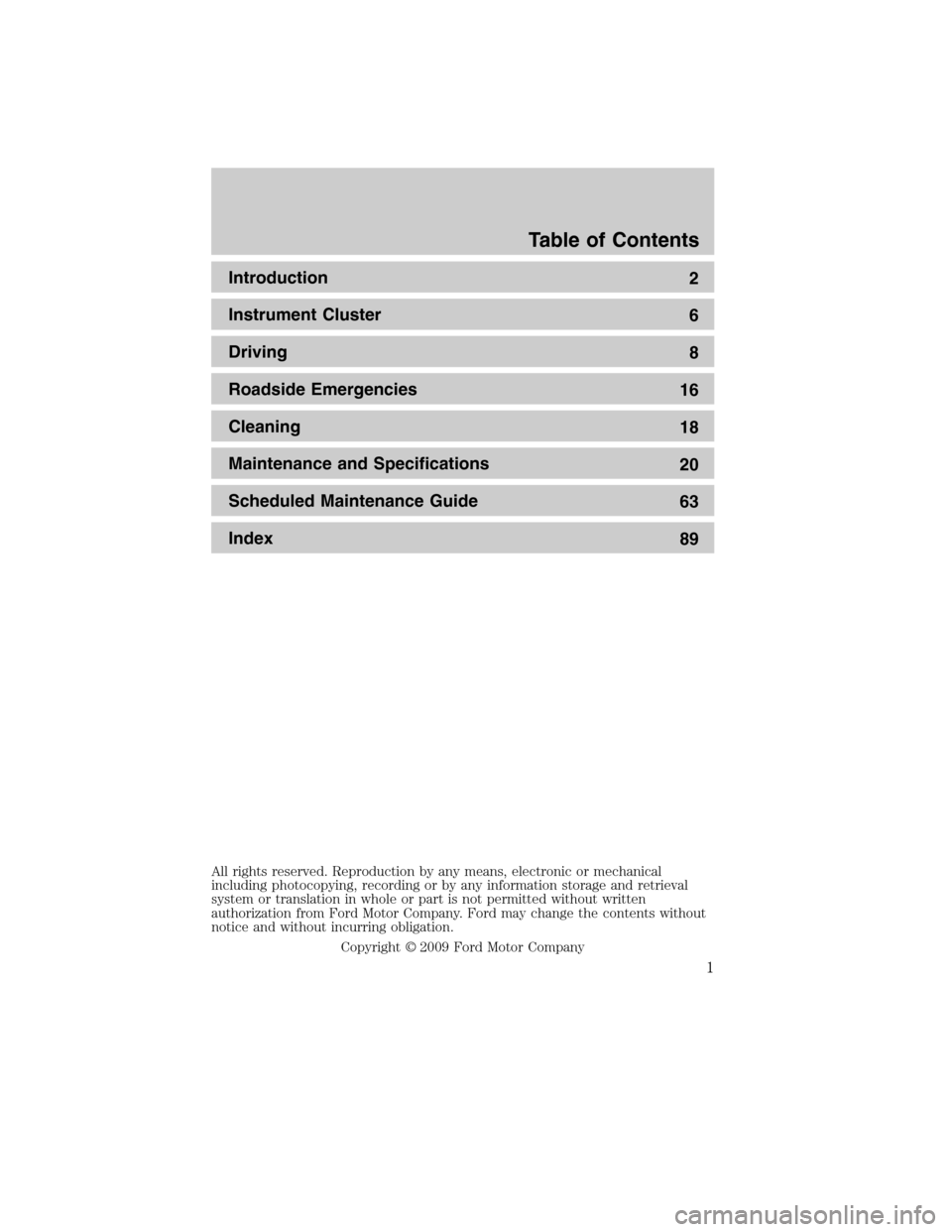
Introduction
2
Instrument Cluster
6
Driving
8
Roadside Emergencies
16
Cleaning
18
Maintenance and Specifications
20
Scheduled Maintenance Guide
63
Index
89
All rights reserved. Reproduction by any means, electronic or mechanical
including photocopying, recording or by any information storage and retrieval
system or translation in whole or part is not permitted without written
authorization from Ford Motor Company. Ford may change the contents without
notice and without incurring obligation.
Copyright © 2009 Ford Motor Company
Table of Contents
1
2011 Econoline(eco)
Supplement, 1st Printing
USA(fus)
Page 6 of 90
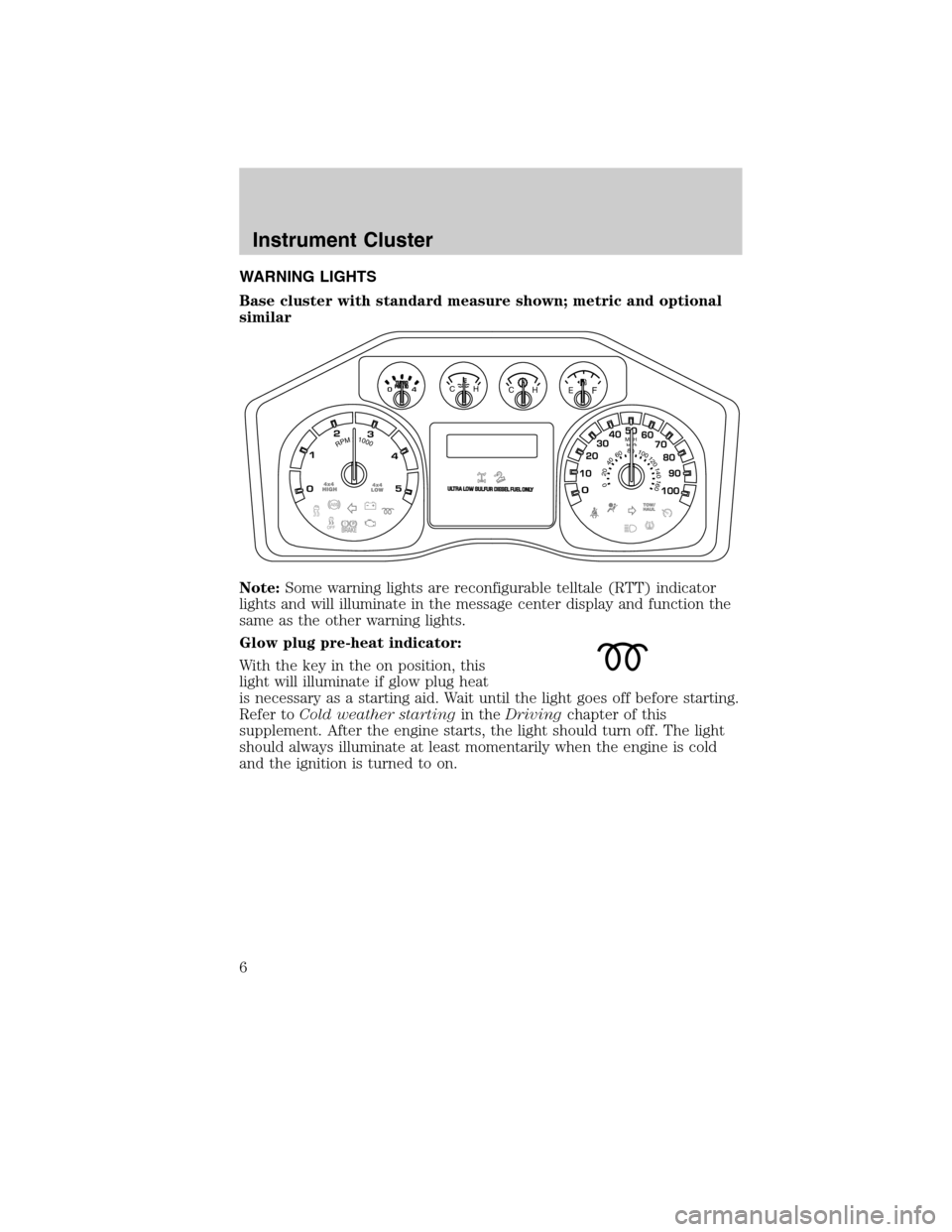
WARNING LIGHTS
Base cluster with standard measure shown; metric and optional
similar
Note:Some warning lights are reconfigurable telltale (RTT) indicator
lights and will illuminate in the message center display and function the
same as the other warning lights.
Glow plug pre-heat indicator:
With the key in the on position, this
light will illuminate if glow plug heat
is necessary as a starting aid. Wait until the light goes off before starting.
Refer toCold weather startingin theDrivingchapter of this
supplement. After the engine starts, the light should turn off. The light
should always illuminate at least momentarily when the engine is cold
and the ignition is turned to on.
04CHCHEF
RPMx1000
0204
060801001
2
01
4
0160
km/hMPH
Instrument Cluster
6
2011 Econoline(eco)
Supplement, 1st Printing
USA(fus)
Page 7 of 90
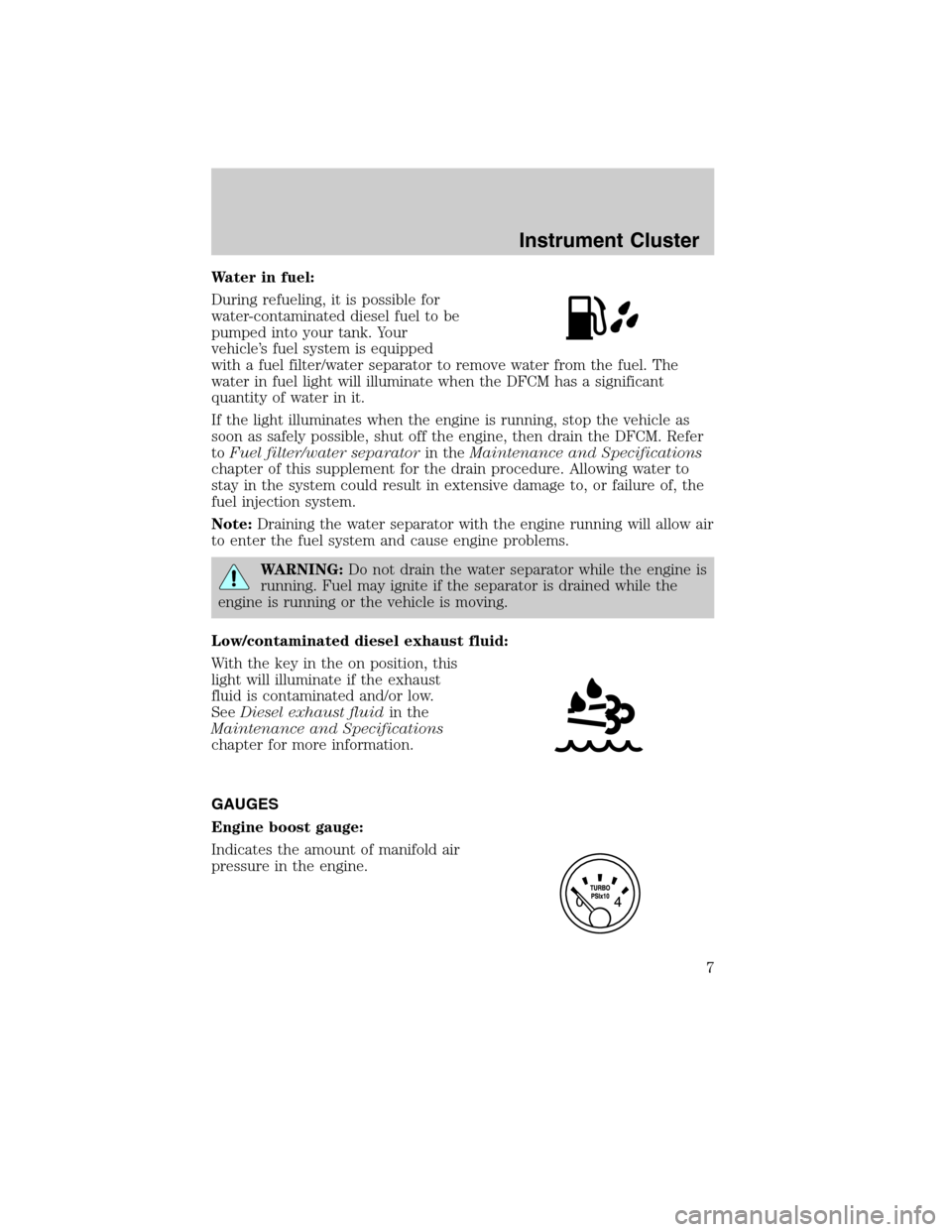
Water in fuel:
During refueling, it is possible for
water-contaminated diesel fuel to be
pumped into your tank. Your
vehicle’s fuel system is equipped
with a fuel filter/water separator to remove water from the fuel. The
water in fuel light will illuminate when the DFCM has a significant
quantity of water in it.
If the light illuminates when the engine is running, stop the vehicle as
soon as safely possible, shut off the engine, then drain the DFCM. Refer
toFuel filter/water separatorin theMaintenance and Specifications
chapter of this supplement for the drain procedure. Allowing water to
stay in the system could result in extensive damage to, or failure of, the
fuel injection system.
Note:Draining the water separator with the engine running will allow air
to enter the fuel system and cause engine problems.
WARNING:Do not drain the water separator while the engine is
running. Fuel may ignite if the separator is drained while the
engine is running or the vehicle is moving.
Low/contaminated diesel exhaust fluid:
With the key in the on position, this
light will illuminate if the exhaust
fluid is contaminated and/or low.
SeeDiesel exhaust fluidin the
Maintenance and Specifications
chapter for more information.
GAUGES
Engine boost gauge:
Indicates the amount of manifold air
pressure in the engine.
Instrument Cluster
7
2011 Econoline(eco)
Supplement, 1st Printing
USA(fus)
Page 26 of 90
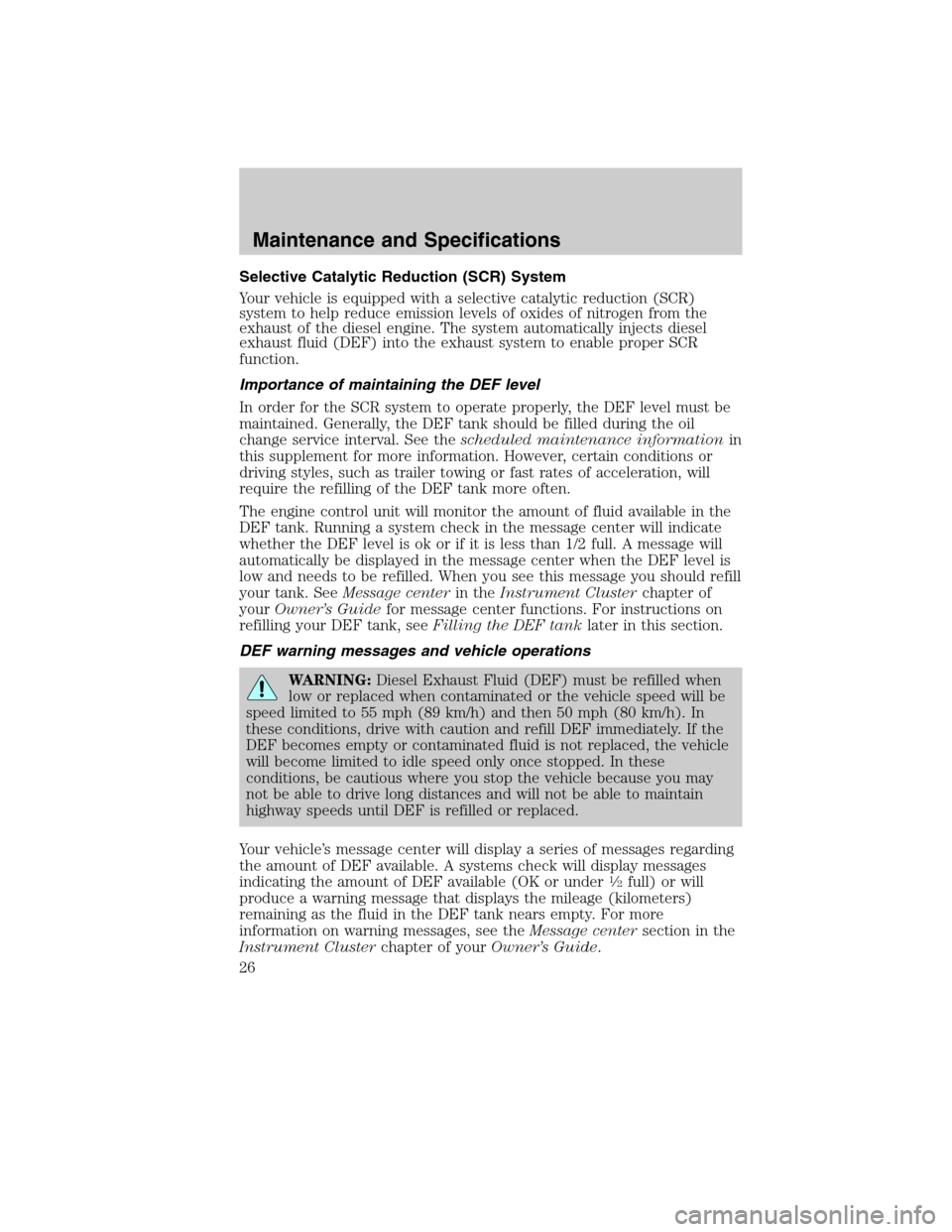
Selective Catalytic Reduction (SCR) System
Your vehicle is equipped with a selective catalytic reduction (SCR)
system to help reduce emission levels of oxides of nitrogen from the
exhaust of the diesel engine. The system automatically injects diesel
exhaust fluid (DEF) into the exhaust system to enable proper SCR
function.
Importance of maintaining the DEF level
In order for the SCR system to operate properly, the DEF level must be
maintained. Generally, the DEF tank should be filled during the oil
change service interval. See thescheduled maintenance informationin
this supplement for more information. However, certain conditions or
driving styles, such as trailer towing or fast rates of acceleration, will
require the refilling of the DEF tank more often.
The engine control unit will monitor the amount of fluid available in the
DEF tank. Running a system check in the message center will indicate
whether the DEF level is ok or if it is less than 1/2 full. A message will
automatically be displayed in the message center when the DEF level is
low and needs to be refilled. When you see this message you should refill
your tank. SeeMessage centerin theInstrument Clusterchapter of
yourOwner’s Guidefor message center functions. For instructions on
refilling your DEF tank, seeFilling the DEF tanklater in this section.
DEF warning messages and vehicle operations
WARNING:Diesel Exhaust Fluid (DEF) must be refilled when
low or replaced when contaminated or the vehicle speed will be
speed limited to 55 mph (89 km/h) and then 50 mph (80 km/h). In
these conditions, drive with caution and refill DEF immediately. If the
DEF becomes empty or contaminated fluid is not replaced, the vehicle
will become limited to idle speed only once stopped. In these
conditions, be cautious where you stop the vehicle because you may
not be able to drive long distances and will not be able to maintain
highway speeds until DEF is refilled or replaced.
Your vehicle’s message center will display a series of messages regarding
the amount of DEF available. A systems check will display messages
indicating the amount of DEF available (OK or under
1�2full) or will
produce a warning message that displays the mileage (kilometers)
remaining as the fluid in the DEF tank nears empty. For more
information on warning messages, see theMessage centersection in the
Instrument Clusterchapter of yourOwner’s Guide.
Maintenance and Specifications
26
2011 Econoline(eco)
Supplement, 1st Printing
USA(fus)
Page 28 of 90

Low DEF Warnings and Actions — Instrument Cluster Messages (Optional message
center messages shown, base message center messages similar)
Distance/DEF Level
or ActionCluster MessageCustomer Requested
ActionsVehicle Actions
Full TankExhaust Fluid
Level OKDrive normally None
Below
1�2TankExhaust Fluid
Under
1�2FullDrive normally None
800 Miles (1287 km)Exhaust Fluid
Range 800 miles
(1287 km)Refill exhaust fluid None
300 Miles (483 km)Exhaust Fluid
Range 300 miles
(483 km)Refill exhaust fluid None
99 Miles (159 km)In 99 Miles
(159 km) Speed
Limited to
55 MPH (89 km/h)
Exhaust Fluid
EmptyRefill exhaust fluid None
*0 Miles (0 km)Speed Limited to
55 MPH (89 km/h)
Max Upon Restart
Exhaust Fluid
EmptyRefill exhaust fluid None
Maintenance and Specifications
28
2011 Econoline(eco)
Supplement, 1st Printing
USA(fus)
Page 29 of 90
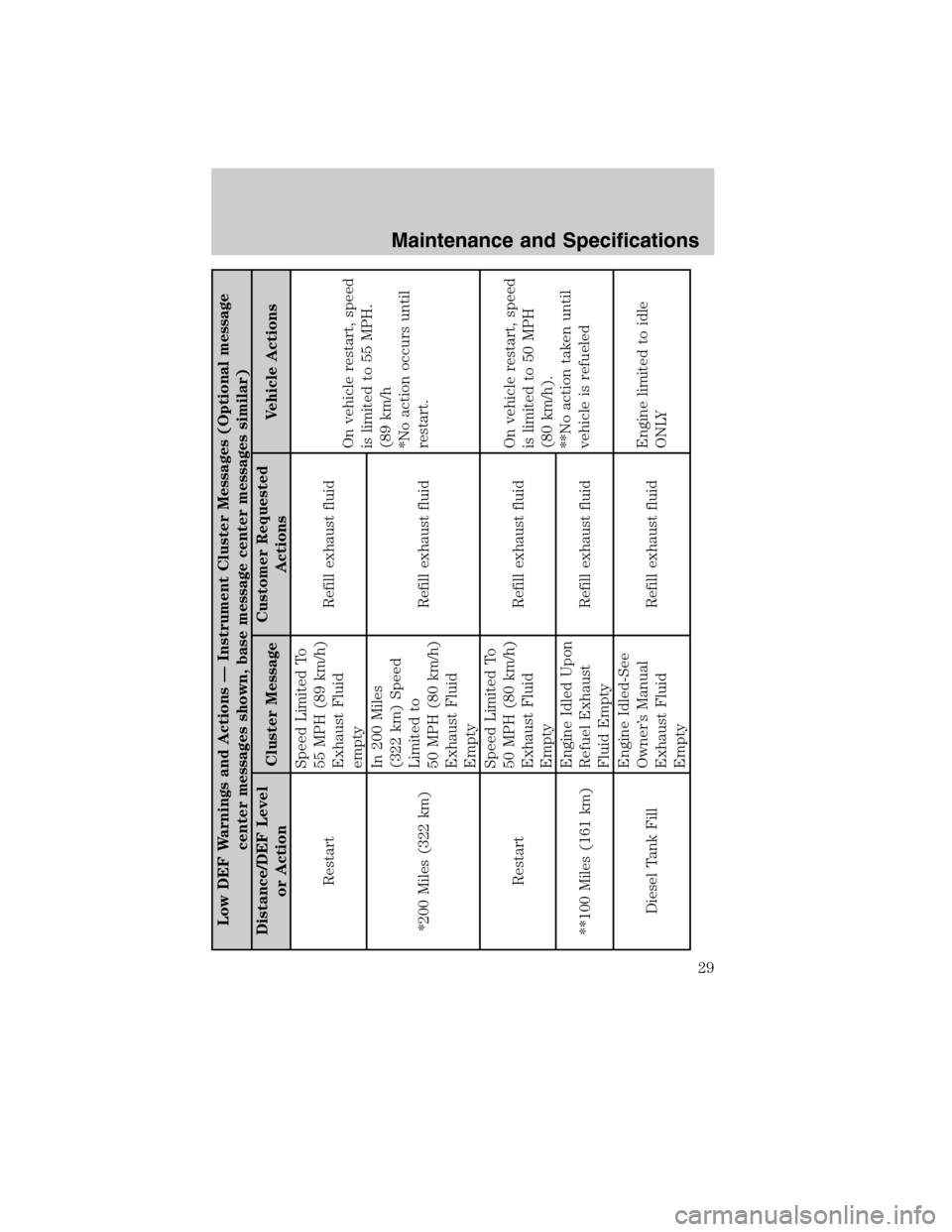
Low DEF Warnings and Actions — Instrument Cluster Messages (Optional message
center messages shown, base message center messages similar)
Distance/DEF Level
or ActionCluster MessageCustomer Requested
ActionsVehicle Actions
RestartSpeed Limited To
55 MPH (89 km/h)
Exhaust Fluid
emptyRefill exhaust fluid
On vehicle restart, speed
is limited to 55 MPH.
(89 km/h
*No action occurs until
restart.
*200 Miles (322 km)In 200 Miles
(322 km) Speed
Limited to
50 MPH (80 km/h)
Exhaust Fluid
EmptyRefill exhaust fluid
RestartSpeed Limited To
50 MPH (80 km/h)
Exhaust Fluid
EmptyRefill exhaust fluidOn vehicle restart, speed
is limited to 50 MPH
(80 km/h).
**No action taken until
vehicle is refueled
**100 Miles (161 km)Engine Idled Upon
Refuel Exhaust
Fluid EmptyRefill exhaust fluid
Diesel Tank FillEngine Idled-See
Owner’s Manual
Exhaust Fluid
EmptyRefill exhaust fluidEngine limited to idle
ONLY
Maintenance and Specifications
29
2011 Econoline(eco)
Supplement, 1st Printing
USA(fus)
Page 42 of 90

1For severe duty usage, use SAE 5W-40 API CJ-4.
2For biodiesel (grades B5-B20) usage, use SAE 5W-40 or SAE
15W-40 API CJ-4.
An engine block heater is recommended at temperatures below –10°F
(–23°C).
A symbol has been developed by the
American Petroleum Institute (API)
to help you select the proper engine
oil. It will be included on the oil
container you purchase. The top
section of the symbol shows the oil
performance by the API designation. This should match the owner guide
recommendation. The center section will show the SAE viscosity grade
Changing the engine oil and oil filter
Your vehicle is equipped with an Intelligent Oil Life Monitor™ that
calculates the proper oil change service interval. When the message
center indicates:OIL CHANGE REQUIRED, change the engine oil and
oil filter. See theMessage centersection of theInstrument Cluster
chapter for more information.
Refer toMotorcraft part numberslater in this chapter for the engine oil
filter part number. This filter protects your engine by filtering harmful,
abrasive or sludge particles and particles significantly smaller than most
available “will-fit” filters.
-20
-100
10 20 30
40
38 32 27 21 16 10 4 -1 -7 -12
-18 -23 -2950 60
7080 9010 0
SAE VISCOSITY GRADES
EXPECTED TEMPERATURE RANGE
F˚
C˚
5W-401,2
0W-30 / 0W-4015W-40
2
10W-30 (Normal Usage)
APISERVICECJ-4/SMSAE10W-30
Maintenance and Specifications
42
2011 Econoline(eco)
Supplement, 1st Printing
USA(fus)
Page 43 of 90
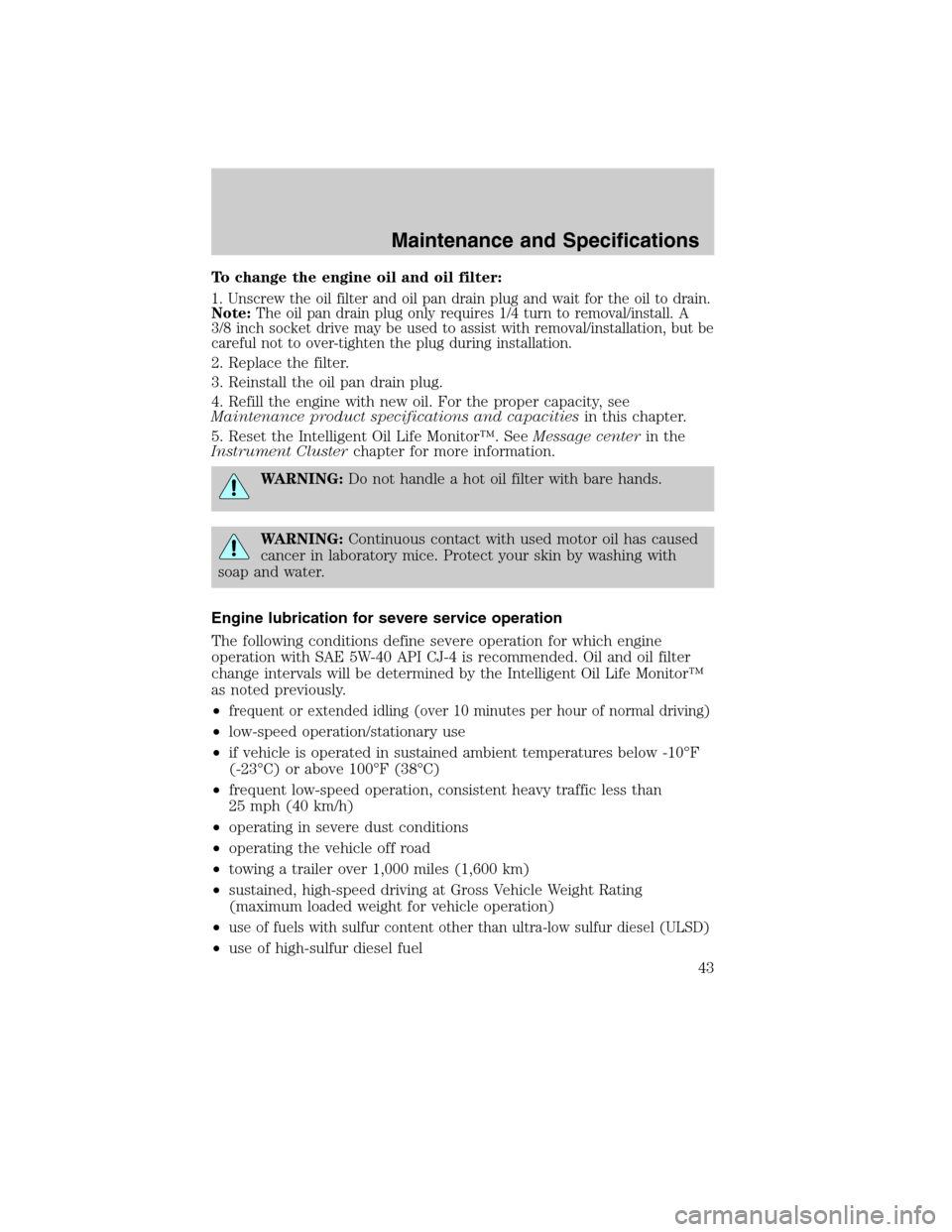
To change the engine oil and oil filter:
1. Unscrew the oil filter and oil pan drain plug and wait for the oil to drain.
Note:The oil pan drain plug only requires 1/4 turn to removal/install. A
3/8 inch socket drive may be used to assist with removal/installation, but be
careful not to over-tighten the plug during installation.
2. Replace the filter.
3. Reinstall the oil pan drain plug.
4. Refill the engine with new oil. For the proper capacity, see
Maintenance product specifications and capacitiesin this chapter.
5. Reset the Intelligent Oil Life Monitor™. SeeMessage centerin the
Instrument Clusterchapter for more information.
WARNING:Do not handle a hot oil filter with bare hands.
WARNING:Continuous contact with used motor oil has caused
cancer in laboratory mice. Protect your skin by washing with
soap and water.
Engine lubrication for severe service operation
The following conditions define severe operation for which engine
operation with SAE 5W-40 API CJ-4 is recommended. Oil and oil filter
change intervals will be determined by the Intelligent Oil Life Monitor™
as noted previously.
•
frequent or extended idling (over 10 minutes per hour of normal driving)
•low-speed operation/stationary use
•if vehicle is operated in sustained ambient temperatures below -10°F
(-23°C) or above 100°F (38°C)
•frequent low-speed operation, consistent heavy traffic less than
25 mph (40 km/h)
•operating in severe dust conditions
•operating the vehicle off road
•towing a trailer over 1,000 miles (1,600 km)
•sustained, high-speed driving at Gross Vehicle Weight Rating
(maximum loaded weight for vehicle operation)
•
use of fuels with sulfur content other than ultra-low sulfur diesel (ULSD)
•use of high-sulfur diesel fuel
Maintenance and Specifications
43
2011 Econoline(eco)
Supplement, 1st Printing
USA(fus)